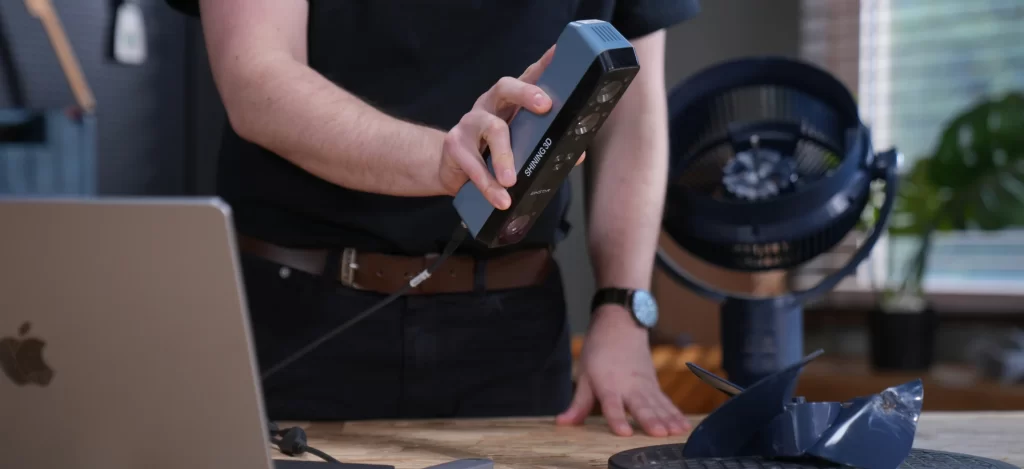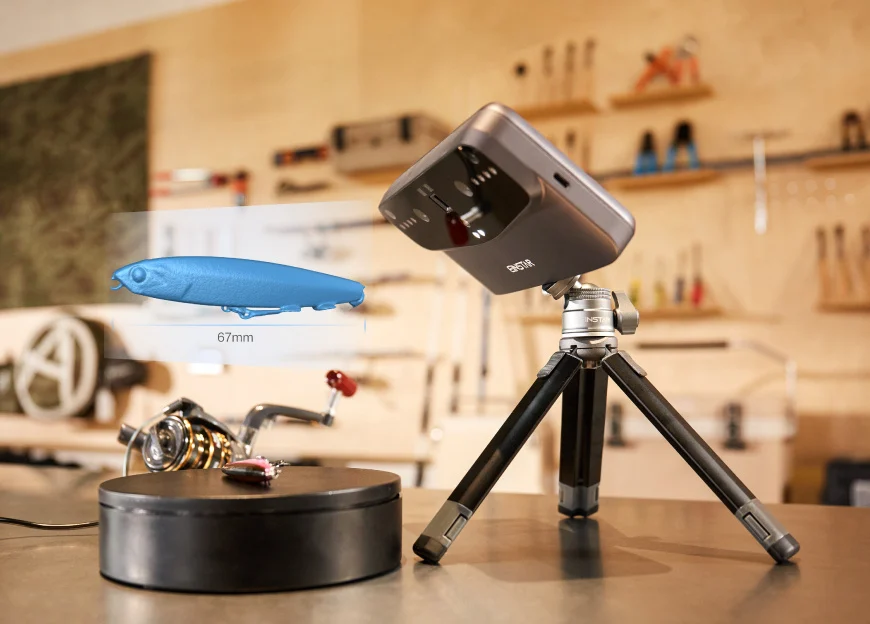3D laser scanners take images of physical objects and turn them into digital models, which you can view and modify in CAD software before sending them to your 3D printer.
You gain precise measurements, complex geometries, and detailed textures from real-world items without laborious manual drafting, measuring, and drawing.
Scanning lets you duplicate, modify or improve physical objects through your 3D printer with minimal effort. Measure once, print many times – all while maintaining dimensions and intricate details that would be impossible to recreate manually.
Here’s what you can create with a 3D scanner:
- Replacement parts: Create duplicates of broken components without measuring
- Custom fittings: Design perfectly fitted mounts for irregular surfaces
- Replication: Reproduce rare or unique items with precise dimensions
- Prototype iteration: Scan physical models for digital modification before printing
- Scale manipulation: Resize physical objects while maintaining proportions
- Documentation: Create permanent digital records of physical objects
How 3D scanners work
3D scanners create digital models by projecting light patterns onto objects and measuring how they interact with surfaces.
Infrared VCSEL technology powers the Shining 3D Einstar Scanner, emitting structured light patterns through three projectors working alongside two stereo-depth cameras.

Your scanner captures depth data by analysing distortions in these patterns as they hit surfaces at different distances from the lens.
Point clouds form the foundation of 3D scans, consisting of thousands of coordinate points in three-dimensional space. Each point represents a specific location on your object’s surface, with the Einstar capturing up to 980,000 points per second.
Distances between points determine scan resolution, with the Einstar achieving point distances as small as 0.1mm for capturing fine details.
Shining 3D Einstar VEGA’s additional capabilities
The Einstar VEGA enhances scanning capabilities with its dual technology approach, combining VCSEL for long-range scanning and MEMS for short-range precision work.

Unlike the handheld Einstar, VEGA operates as a standalone unit with built-in computing power, 32GB RAM and 512GB storage, eliminating the need for connected computers.
Its wireless functionality lets you transfer scans directly to the SHINING 3D Cloud or project onto secondary displays.
The 6.4-inch 2K AMOLED screen provides excellent visibility, while the lightweight magnesium alloy body (535g) supports extended use. HD Mode captures fine details at 15fps, while Fast Mode handles larger objects at 20fps.
Capturing dark and reflective surfaces
Most 3D scanners struggle with black or shiny surfaces because light absorbs into dark materials rather than reflecting to sensors.
Light bounces unpredictably off glossy surfaces, creating scattered readings and holes in scan data. Infrared VCSEL technology solves these problems with wavelengths better suited for challenging materials, maintaining accuracy when scanning reflective metals or dark plastics.
The use of a residue-free, self-evaporating 3D scanning spray to temporarily give gloss surfaces a matt finish or lighter colour better suited for scanning can also be beneficial.
Working distance significantly affects scan quality, with the Shining 3D Einstar Scanner operating between 160mm and 1400mm from surfaces.
Using the optimal 400mm distance ensures the best results, allowing scans to capture a field of view measuring 434mm × 379mm in a single pass. Moving beyond recommended distances reduces point density and detail capture in final models.
Converting scans to printable files
Raw point clouds need processing before becoming 3D-printable models. Software merges multiple scan passes into cohesive meshes to create watertight surfaces and remove scanning artefacts with automated algorithms.
Alignment modes help you create cohesive images. Feature, hybrid, texture, and global markers accommodate different object types and scanning environments.
Once you have your scan, you can export it as an OBJ, STL, PLY, P3, or 3MF file to suit your design software. Each maintains colour information captured by the built-in RGB camera.
Hardware requirements
Your computer needs sufficient processing power to run a handheld scanner’s software and process captured data. The Einstar Handheld Scanner connects via USB, while its companion software handles all data processing and model creation on your PC.
Einstar provides an example spec for hardware requirements:
- Windows 10 (64-bit)
- Intel i7-7700H processor
- 16GB memory
- GTX 1050 graphics card with 4GB video memory
Processing complex scan data demands significant computing resources, especially when handling high-resolution colour textures and dense meshes.
Some lower-spec computers can still operate the scanner but might experience slower processing when converting raw scans into usable 3D models.
Practical scanning techniques
Consistent movement helps achieve complete scans without data gaps. Moving too quickly causes missed sections while scanning too slowly creates unnecessary data overlap.
Practice maintaining steady pacing around objects while watching the real-time quality indicator to ensure sufficient coverage of all surfaces.
Environmental lighting affects scan quality substantially despite the infrared technology’s resilience. Outdoor scanning works reliably with the Einstar, though direct sunlight can sometimes overwhelm sensors.
Indoor environments with controlled lighting produce more consistent results, particularly when scanning small objects requiring maximum detail capture.
Scanning human subjects requires additional considerations, particularly for capturing hair. Einstar’s units have a dedicated “Hair Mode” that increases data capture in these challenging areas, improving overall model completeness.
No visible light projector means models remain comfortable during full-body scans, avoiding eye strain common with visible-light systems.
From scan to print
Scans provide starting points for design modifications before printing. After scanning objects, you can scale dimensions, add new features or remove imperfections in CAD software before sending files to printers.
Businesses increasingly incorporate scanning into production environments for quality control, comparing printed parts against original designs through dimensional analysis.
Scanning manufactured items reveals deviations from intended specifications, helping refine printing parameters for maximum accuracy in subsequent production runs.
At £795 (or £954 including VAT), the Einstar Handheld Scanner represents an accessible entry point into professional-quality 3D scanning. Your investment enables rapid digitisation of physical objects, accelerating design processes while improving accuracy.
The Einstar VEGA is even more capable, offering dual scanning technologies in one lightweight device. It combines VCSEL technology for long-range scanning with MEMS for capturing short-range precision details.
When paired with quality 3D printers, such as models from Bambu Lab, Markforged, and Formlabs, you close the digital-physical loop in your workshop or production facility, independently expanding capabilities beyond what either technology offers.




